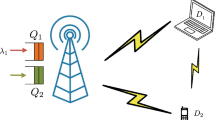Abstract
Wireless communications are vulnerable to signal jamming attacks. Spread spectrum mitigates these attacks by spreading normal narrowband signals over a much wider band of frequencies and forcing jammers who do not know the spreading pattern to expend much more effort to launch the attack. In broadcast systems, however, jammers can easily find out the spread pattern by compromising just a single receiver. Several group-based ideas have been proposed to deal with compromised receivers; they can tolerate up to t malicious receivers by adding 2t extra copies for each broadcast message. In this paper, we propose a novel scheme with random channel sharing. This scheme reduces the communication cost from 2t to (1 + p)t extra copies, where p determines the channel sharing probability (0 < p < 1). In addition, it does not increase the hardware complexity as it does not require a receiver to operate on multiple channels at the same time.







Similar content being viewed by others
References
Chiang, J. T., & Hu, Y. (2008). Dynamic jamming mitigation for wireless broadcast networks. In INFOCOM 2008. The 27th conference on computer communications. IEEE, pp. 1211–1219, April 2008.
Desmedt, Y., Safavi-Naini, R., Wang, H., Batten, L., Charnes, C., & Pieprzyk, J. (2001). Broadcast anti-jamming systems. Computer Networks, 35(2–3), 223–236.
Dong, Q., Liu, D., & Ning, P. (2008). Pre-authentication filters: Providing dos resistance for signature-based broadcast authentication in wireless sensor networks. In Proceedings of ACM conference on wireless network security (WiSec).
Lazos, L., Liu, S., & Krunz, M. (2009). Mitigating control-channel jamming attacks in multi-channel ad hoc networks. In WiSec ’09: Proceedings of the second ACM conference on wireless network security.
Li, M., Koutsopoulos, I., & Poovendran, R. (2007). Optimal jamming attacks and network defense policies in wireless sensor networks. In IEEE international conference on computer communications (INFOCOM), pp. 1307–1315, May 2007.
Lin, G., & Noubir, G. (2005). On link layer denial of service in data wireless lans. Wireless Communications and Mobile Computing, 5(3), 273–284.
Liu, Y., Ning, P., Dai, H., & Liu, A. (2010). Randomized differential dsss: Jamming-resistant wireless broadcast communication. In Proceedings of the 29th IEEE international conference on computer communications (INFOCOM ’10).
Liu, D., Raymer, J., & Fox, A. (2012). Efficient and timely jamming detection in wireless sensor networks. In Proceedings of IEEE international conference on mobile ad hoc and sensor systems (MASS), October 2012 (to appear).
Poisel, R. A. (2003). Modern communications jamming principles and techniques. London: Artech House Publishers.
Popper, C., Strasser, M., & Capkun, S. (2009). Jamming-resistant broadcast communication without shared keys. In Proceedings of the 18th conference on USENIX security symposium.
Simon, M. K., Omura, J. K., Scholtz, R. A., & Levitt, B. K. (2001). Spread spectrum communications handbook. New York: McGraw-Hill, Inc.
Slater, D., Tague, P., Poovendran, R., & Matt, B. J. (2009). A coding-theoretic approach for efficient message verification over insecure channels. In WiSec ’09: Proceedings of the second ACM conference on Wireless network security, pp. 151–160. ACM.
Strasser, M., Pöpper, C., Capkun, S., & Cagalj, M. (2008). Jamming-resistant key establishment using uncoordinated frequency hopping. In Proceedings of the 2008 IEEE symposium on security and privacy (SP), pp. 64–78. IEEE Computer Society.
Strasser, M., Pöpper, C., & Čapkun, S. (2009). Efficient uncoordinated fhss anti-jamming communication. In MobiHoc ’09: Proceedings of the tenth ACM international symposium on mobile ad hoc networking and computing, pp. 207–218. ACM.
Tague, P., Li, M., & Poovendran, R. (2009). Mitigation of control channel jamming under node capture attacks. IEEE Transactions on Mobile Computing, pp. 1221–1234, IEEE Computer Society.
Viterbi, A. J. (1995). CDMA Principles of spread spectrum communication. Reading, MA: Addison-Wesley.
Xu, W., Trappe, W., Zhang, Y., & Wood, T. (2005). The feasibility of launching and detecting jamming attacks in wireless networks. In Proceedings of ACM international symposium on mobile ad hoc networking and computing (MobiHoc).
Acknowledgments
This material is based upon work supported by the National Science Foundation under Grant No. CNS-0916221. We also thank anonymous reviewers for their feedback, which has helped to improve the paper.
Author information
Authors and Affiliations
Corresponding author
Additional information
A preliminary version of this paper appeared in the Proceedings of the International Conference on Distributed Computing Systems (ICDCS), 2010.
Rights and permissions
About this article
Cite this article
Dong, Q., Liu, D. & Wright, M. Mitigating jamming attacks in wireless broadcast systems. Wireless Netw 19, 1867–1880 (2013). https://doi.org/10.1007/s11276-013-0574-0
Published:
Issue Date:
DOI: https://doi.org/10.1007/s11276-013-0574-0




